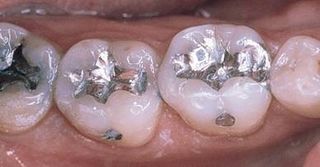The problem with Dr. Oz's approach is that he conveniently leaves out much of the facts and thousands of studies that have been done showing the safety and efficacy of amalgam fillings. Instead he goes for shock value to scare his viewers into thinking they have toxic fillings. A dental friend put together a great post a couple of years ago discussing this very topic. His rationale describes very precisely our feelings towards amalgam feelings. Are they giving you psychological and emotional problems? No. Are they very esthetic or conservative? No. Should people run out and have all of their amalgam fillings replaced? No. There are only two reasons why we encourage our patients to replace their metal fillings. One is if the filling is breaking down and has decay. The other is for esthetic reasons. If you don't like the way they look, then yes we will replace them for you.
Here is the article:
"What's the deal with silver fillings? Why is it that we see news stories every once in awhile questioning the safety of dental amalgam? The answer, in a nutshell, is Mercury.

The
element Mercury (Hg) is highly toxic. Think broken thermometers and
fluorescent light bulbs. Avoiding Mercury exposure is highly
recommended. As an element, Mercury is poisonous.
Another
element, Chlorine (Cl), is also highly toxic. Yet, when combined with
the element Sodium (Na) you get a chemical that is common, safe and in
reasonable doses, delicious. Common table salt is a chemical compound
called Sodium chloride (NaCl) and is perfectly safe to eat in moderate
amounts. But no one in their right mind would go out of their way to
ingest Sodium or Chlorine on their own. The same goes for Mercury.
"Silver
fillings" aren't really fillings made of Silver. They are a combination
of Mercury, Silver, Copper, Tin and other trace metals. Silver fillings
are placed by thoroughly mixing these ingredients. The ingredients mix
and form an alloy of the metals. This alloy is different than any of the
ingredients individually. In other words, there isn't just Mercury,
Silver, Tin or Copper in there. It's a whole new chemical compound made
up of all of these metals. It's kind of like concrete. You start with cement,
sand, stone and water. The final product is concrete. You can't go back
and take the ingredients out of concrete without breaking down the
concrete chemically.
The
bottom line is that there's no such thing as "Mercury fillings." Dental
amalgam has Mercury in it that is chemically combined with other metals
to form an alloy. One of the properties of Mercury is it's ability to
form an alloy like this at room temperature.
Can
dental amalgam "leak" Mercury? Yes. There can be a very slight release
of mercury from amalgam fillings. A study conducted by measuring the
Mercury vapor levels inside the mouth over a 24-hour period in patients
with at least nine amalgam restorations showed the average daily dose of
inhaled mercury vapor was 1.7 µg (micrograms), which is approximately
only 1% of the threshold limit value of 300 to 500 µg/day established by
the World Health Organization. So there is Mercury released from
fillings, but it's a very tiny amount.
What about Mercury exposure from dental amalgams causing diseases? The American Dental Association has
weighed in regarding the safety and efficacy of dental amalgam.
Scientific evidence concludes that the use of dental amalgam is safe.
There is no evidence to support removing silver fillings in an effort to
cure or prevent other diseases.
Dental
amalgam has undoubtedly saved millions of teeth in its 100+ years of
use. Until relatively recently there haven't been inexpensive options to
restore teeth that could hold a candle to silver fillings. They're
durable as heck and they're relatively easy and inexpensive to place.
- They're ugly. When polished they can be shiny and smooth, but they don't look like a tooth. They look like metal, which they are.
- In order to place a silver filling you need to remove a lot of tooth structure. In a tooth that's never been filled before, this means that you're cutting away more tooth structure than you need to.
To
me, those are the main down sides to using dental amalgam. Perhaps
these down sides deserve their own post (stay tuned!) I place very few
dental amalgams any more because I'm confident that I can place an
excellent bonded resin restoration (a.k.a: composite) in any situation that I might have used amalgam.
But my reasons for using composite fillings has nothing to do with Mercury. In my mind, the Mercury is a non-issue."
If you have any questions, feel free to call us (435-649-4343) and we would love to discuss this with you. Or you can visit our website to learn more as well.

The American Dental Association also released a statement today about this:
ReplyDelete“The Doctor Oz Show” features sensationalistic segment on dental amalgam
“The Dr. Oz Show,” aired a segment March 28 based largely on junk science which may alarm your patients about the safety of dental amalgam. The nationally syndicated daytime health talk show is hosted by cardiothoracic surgeon Dr. Mehmet Oz.
Although the show’s producer contacted the ADA for information beforehand, our repeated offers to arrange an interview with an ADA spokesperson dentist were declined. The producer would only accept written statements from the ADA, which we provided. These statements are posted on the Doctor Oz show website. The ADA will also issue a press statement about the show.
Your patients may ask you about the safety of dental amalgam based on the Dr. Oz segment. Here is a link to the ADA Council on Scientific Affairs statement on dental amalgam.
In addition, here are some points that may help you discuss the issue with your patients:
Silver-colored fillings, also called dental amalgam, are safe, durable, and affordable and have been used for generations.
Amalgam is one of several materials I use. There are also tooth colored materials and gold.
The decision about what material to use is based on a variety of factors such as size and location of a cavity, insurance coverage, and any cosmetic concerns you might have. There’s really no “one size fits all” approach.
[IF APPLICABLE] I’ve used amalgam for years and have amalgam fillings in my own mouth.
Major health and scientific bodies around the world agree that based on extensive scientific evidence, amalgam is safe and effective for dental patients.
Always feel free to talk with me about your dental treatment options. As your doctor, I want to answer any questions you may have so you can make informed decisions about your dental care.
The best dental filling is no dental filling, so be sure to brush, floss and eat a balanced diet to help prevent cavities in the first place
The American Dental Association’s website at www.MouthHealthy.org has a lot of information on dental materials and how to take care of your oral health.
If your patients ask about the demonstration on the Dr. Oz show measuring the release of vapor from brushing teeth in a synthetic mouth model with amalgam fillings, here is some information you may find useful to share with your patients:
That demonstration is misleading and doesn’t take real world conditions into account. For example, the mouth model on the show is in a closed, dry environment, yet people have saliva in their mouths which reduces vapor activity. Credible scientific studies show that the amount of vapor released from amalgam fillings is so small it’s in the billionths of a single ounce. A noted researcher calculated that it would take nearly 300 amalgam fillings in real life for even the most sensitive person to exhibit symptoms.
Lastly, your patients may ask whether dental amalgam raises their risk of certain health conditions. You may want to share the following:
Not a single credible scientific study supports such a position. In fact, a number of organizations such as the American Academy of Pediatrics, National Multiple Sclerosis Society, and the Alzheimer’s Association have made statements about amalgam based on scientific evidence which you can access online.